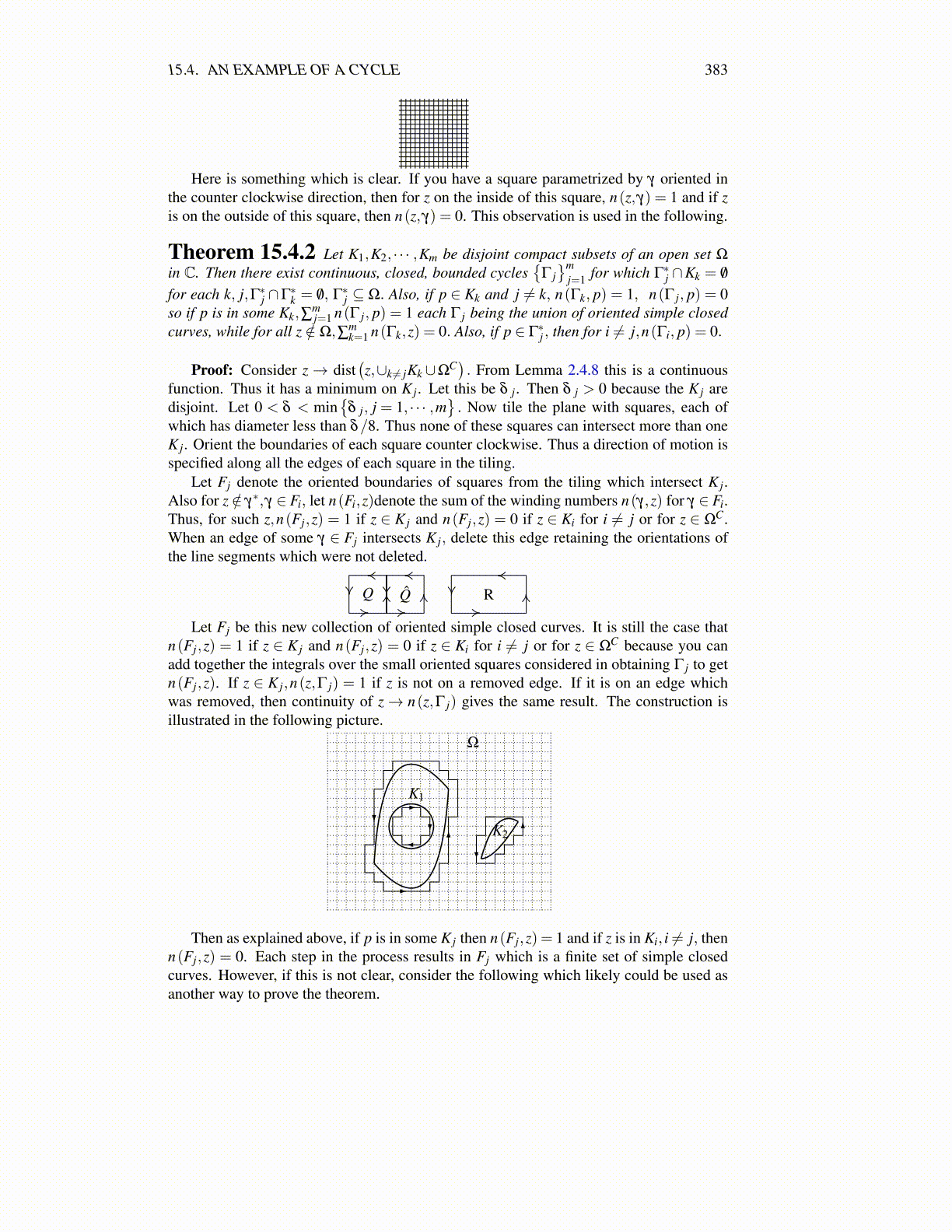
15.4. AN EXAMPLE OF A CYCLE 383
Here is something which is clear. If you have a square parametrized by γ oriented inthe counter clockwise direction, then for z on the inside of this square, n(z,γ) = 1 and if zis on the outside of this square, then n(z,γ) = 0. This observation is used in the following.
Theorem 15.4.2 Let K1,K2, · · · ,Km be disjoint compact subsets of an open set Ω
in C. Then there exist continuous, closed, bounded cycles{
Γ j}m
j=1 for which Γ∗j ∩Kk = /0for each k, j,Γ∗j ∩Γ∗k = /0, Γ∗j ⊆ Ω. Also, if p ∈ Kk and j ̸= k, n(Γk, p) = 1, n(Γ j, p) = 0so if p is in some Kk,∑
mj=1 n(Γ j, p) = 1 each Γ j being the union of oriented simple closed
curves, while for all z /∈ Ω,∑mk=1 n(Γk,z) = 0. Also, if p ∈ Γ∗j , then for i ̸= j,n(Γi, p) = 0.
Proof: Consider z→ dist(z,∪k ̸= jKk ∪ΩC
). From Lemma 2.4.8 this is a continuous
function. Thus it has a minimum on K j. Let this be δ j. Then δ j > 0 because the K j aredisjoint. Let 0 < δ < min
{δ j, j = 1, · · · ,m
}. Now tile the plane with squares, each of
which has diameter less than δ/8. Thus none of these squares can intersect more than oneK j. Orient the boundaries of each square counter clockwise. Thus a direction of motion isspecified along all the edges of each square in the tiling.
Let Fj denote the oriented boundaries of squares from the tiling which intersect K j.Also for z /∈ γ∗,γ ∈ Fi, let n(Fi,z)denote the sum of the winding numbers n(γ,z) for γ ∈ Fi.Thus, for such z,n(Fj,z) = 1 if z ∈ K j and n(Fj,z) = 0 if z ∈ Ki for i ̸= j or for z ∈ ΩC.When an edge of some γ ∈ Fj intersects K j, delete this edge retaining the orientations ofthe line segments which were not deleted.
Q Q̂ R
Let Fj be this new collection of oriented simple closed curves. It is still the case thatn(Fj,z) = 1 if z ∈ K j and n(Fj,z) = 0 if z ∈ Ki for i ̸= j or for z ∈ ΩC because you canadd together the integrals over the small oriented squares considered in obtaining Γ j to getn(Fj,z). If z ∈ K j,n(z,Γ j) = 1 if z is not on a removed edge. If it is on an edge whichwas removed, then continuity of z→ n(z,Γ j) gives the same result. The construction isillustrated in the following picture.
K1
K2
Ω
Then as explained above, if p is in some K j then n(Fj,z) = 1 and if z is in Ki, i ̸= j, thenn(Fj,z) = 0. Each step in the process results in Fj which is a finite set of simple closedcurves. However, if this is not clear, consider the following which likely could be used asanother way to prove the theorem.